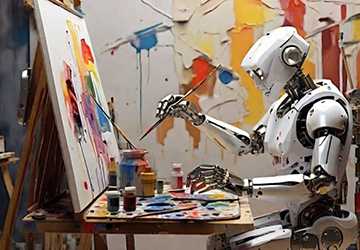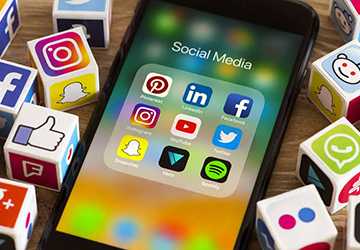The Intersection of Art and Technology A New Creative Era
The symbiosis of art and technology heralds an unparalleled creative epoch, metamorphosing artistic creation, dissemination, and experiential engagement paradigms. This convergence has engendered transformative innovations, harmonizing the realms of traditional and digital artistry.
The symbiosis of art and technology heralds an unparalleled creative epoch, metamorphosing artistic creation, dissemination, and experiential engagement paradigms. This convergence has engendered transformative innovations, harmonizing the realms of traditional and digital artistry.

The Evolution of Tech in the Art World
The infusion of tech in the art world has precipitated a paradigmatic shift in artistic methodology. From digital illustration to immersive virtual reality experiences, technology furnishes artists with tools of unparalleled potential.
- Digital illustration software empowers boundless creativity, unfettered by the constraints of human materials.
- Augmented reality (AR) and virtual reality (VR) afford immersive experiences, animating art in unprecedented dimensions.
- Distributed ledger technology offers an impregnable paradigm for validating and monetizing digital artistry, ensuring the protection of creators' prerogatives.
Digital Art Technology: Tools and Platforms
The ascendancy of digital art technology has introduced many sophisticated tools and platforms, empowering artists to fabricate intricate digital masterpieces with global reach.
- Graphic tablets and styluses simulate the tactile sensation of traditional painting, providing precision and control.
Advanced software like Adobe Creative Suite, Corel Painter, and Procreate offer digital artisans a wide range of features.
- Online platforms such as DeviantArt, Behance, and ArtStation enable artists to exhibit their oeuvre to a global audience, garnering recognition and opportunities.
The Future of Art and Tech Collaboration
Envisioning the horizon, the future of art and tech collaboration portends even more innovative prospects. As technology perpetually evolves, it will further augment artistic expression and expand the frontiers of creativity.
Artificial Intelligence (AI) can scrutinize and engender artistic creations, presenting unprecedented perspectives and methodologies for visual arts connoisseurs and practitioners.
- Machine learning algorithms assist artists in exploring new styles and patterns, pushing the envelope of their creativity.
- Interactive installations and multimedia performances amalgamate physical and digital art, creating sui generis and engaging experiences.
Bridging Cultures and Communities
The future of art and tech collaboration holds the potential to bridge cultures and communities, fostering greater understanding and appreciation of diverse artistic expressions.
- Virtual reality exhibitions allow individuals from disparate parts of the world to experience art from various cultures.
- Collaborative online platforms enable artists from diverse backgrounds to work together, blending their unique styles and perspectives.
- Advancements in technology engender the perpetuation and propagation of cultural patrimony, guaranteeing the persistence and flourishing of traditional artistic expressions in the contemporary digital epoch.
The Function of Distributed Ledger Technology
The future of art and tech collaboration offers solutions to some of the most pressing issues in the digital art sphere.
- NFTs (Non-Fungible Tokens) offer a mechanism to verify the authenticity and ownership of digital art.
- Blockchain ensures transparent and secure transactions, safeguarding artists' intellectual property rights.
- Decentralized platforms enable artists to reach a global market, bypassing traditional gatekeepers.
Impact of Tech in the Art World on Art Education
The ramifications of tech in the art world extend to art education, providing novel modalities for students to learn and engage with art.
- Online courses and tutorials democratize art education, making it accessible to anyone, anywhere.
- Virtual art classes and workshops enable students to learn globally from preeminent artists and instructors.
- Educational software and apps offer interactive lessons, enhancing the educational experience.
Digital Art Technology and Accessibility
This democratization of art has enabled a broader spectrum of individuals to engage with and appreciate artistic endeavours.
- Social media platforms like Instagram and Pinterest allow artists to disseminate their work to a broad audience, garnering instant feedback and recognition.

- Online galleries and virtual exhibitions provide a platform for artists to display their work without necessitating physical space.
- Digital tools enable artists with disabilities to create art, surmounting physical limitations.
Digital Art Technology: A Catalyst for Creative Innovation
Digital art technology catalyzes creative innovation, pushing the boundaries of what is possible in art.
- Interactive art installations that respond to viewer movements and inputs create dynamic and engaging experiences.
- Generative art, created using algorithms and AI, introduces novel forms of artistic expression.
- Digital sculpting and 3D printing enable the creation of intricate and complex artworks that were previously infeasible.
Challenges and Opportunities in Tech in the Art World
Integrating tech in art presents challenges and opportunities for artists and the industry.
- The rapid pace of technological advancement necessitates continual skill updates and adaptation to new tools.
- Intellectual property issues and digital piracy pose significant challenges, necessitating robust legal frameworks.
- However, technology also offers unprecedented opportunities for innovation, Collaboration, and audience expansion.
Virtual Reality and Augmented Reality: Transformative Tools in Art
It provides artists with immersive and interactive mediums that revolutionize traditional artistic practices.
- VR enables artists to fabricate and manipulate art in a tridimensional virtual milieu, offering an untrammelled dimension of creative freedom.
- AR superimposes digital elements onto the human world, allowing artists to amalgamate reality and virtual imagery seamlessly.
- These technologies facilitate unprecedented interactive exhibitions where audiences can engage with art in immersive environments, evoking multisensory experiences.
The Intersection of Art, Technology, and Culture
The future of art and tech collaboration is intricately entwined with cultural expression, enabling novel forms of storytelling and heritage preservation.
- Digital Ethnography: Uses digital tools to document and conserve cultural practices and traditions, ensuring they are accessible to posterity.
- Transmedia Storytelling: Integrates multiple digital platforms to narrate complex, multi-layered stories that transcend conventional narratives.
- Virtual Museums: Create immersive, online museum experiences that allow global audiences to explore cultural artefacts and exhibits, transcending geographical limitations.
The Role of Tech in Collaborative Art Projects
Technology facilitates unparalleled Collaboration in art, enabling artists from diverse backgrounds to co-create and innovate.
- Cloud-based studios Permit artists to collaborate in real-time, regardless of geographic location, fostering global artistic Collaboration.
Blockchain for Collaboration ensures transparent and secure collaborative efforts, tracks contributions, and provides equitable distribution of profits.
- Virtual Reality Collaboration: Enables artists to co-create in shared virtual environments, amalgamating their skills and perspectives in innovative ways.
Conclusion
The intersection of art and technology marks the advent of a new creative era, where tech in the art world, digital art technology, and the future of art and tech collaboration are reshaping the landscape of artistic expression. As we continue to explore this exhilarating convergence, the possibilities for innovation, Collaboration, and cultural exchange are boundless. This new era augments how we create and experience art and democratizes access, ensuring that all can appreciate and enjoy art.